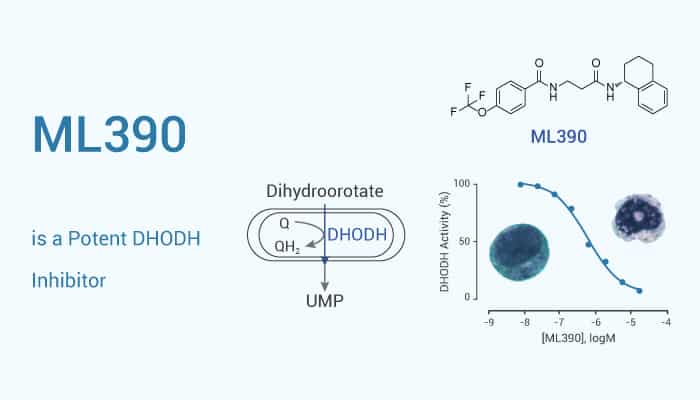Dihydrowhey dehydrogenase (DHODH) catalyzes the fourth enzymatic step of pyrimidine biosynthesis, namely, ubiquinone mediated oxidation of dihydrowhey acid to whey acid. Specifically, DHODH is a mitochondrial protein located on the outer surface of the mitochondrial inner membrane (IMM). Inhibitors of the enzyme are used to treat autoimmune diseases such as rheumatoid arthritis. Besides, DHODH is a ubiquitous FMN flavoprotein. It is also the only enzyme in the pyrimidine biosynthesis pathway in mitochondria, not in the cytoplasm. Moreover, DHODH is an enzyme associated with the electron transport chain. Furthermore, DHODH can connect the bioenergy of mitochondria, cell proliferation, ROS production, and apoptosis of some cell types. The consumption of DHODH also increased ROS production, decreased membrane potential, and delayed cell growth.
Similarly, due to its role in DNA synthesis, inhibition of DHODH may provide a means to regulate transcriptional elongation. Meanwhile, DHODH inhibitors exert potent differentiation activity in vitro and in vivo in both murine and human models of acute myeloid leukemia (AML). Nonetheless, the anti-leukemic activity of DHODH inhibitors points toward a novel link between uridine biosynthesis and cell-fate decisions. And this may offer a much-needed new therapeutic option for the treatment of patients with AML. Here, we will introduce a potent DHOD inhibitor, ML390.

ML390 is a Potent DHODH Inhibitor
First of all, ML390 is a potent dihydroorotate dehydrogenase (DHODH) inhibitor. Particularly, ML390 is an inducer of myeloid differentiation and causes myeloid differentiation in murine (ER-HoxA9) and human (U937 and THP1) AML models.
In the second place, ML390 is active with an ED50 of ~2 μM in murine and human AML cell lines. In vitro, treatment of Lys-GFP-ER-HoxA9 cells with ML390 for 48 hr inhibits DHODH activity. Obviously, it leads to the dramatic (>500-fold) accumulation of the upstream metabolite DHO and the depletion of uridine and other downstream metabolites. In addition, changes in gene expression in lys-gfp-er-hoxa9 cells with ML390 for 12, 36, and 72 hours were similar to primary neutrophil differentiation.
All in all, ML390 is a potent DHODH inhibitor.
References:
David B Sykes, et al. Cell. 2016 Sep 22;167(1):171-186.e15.